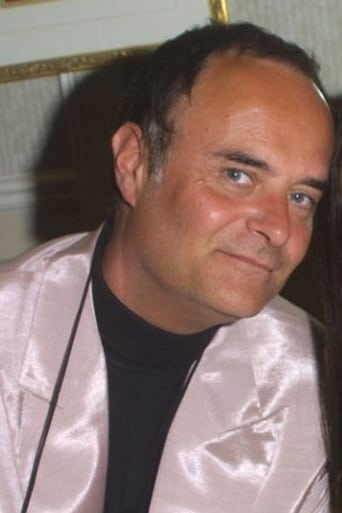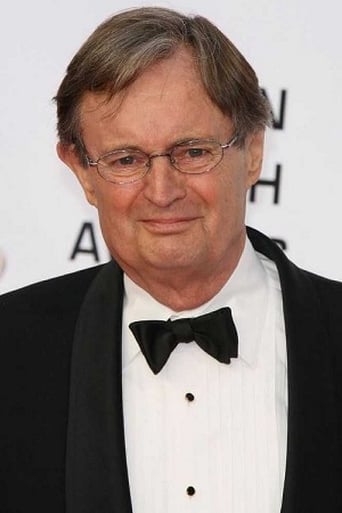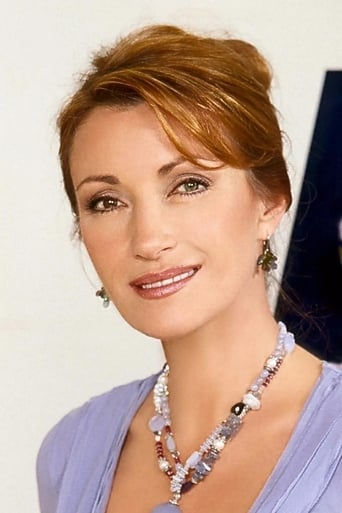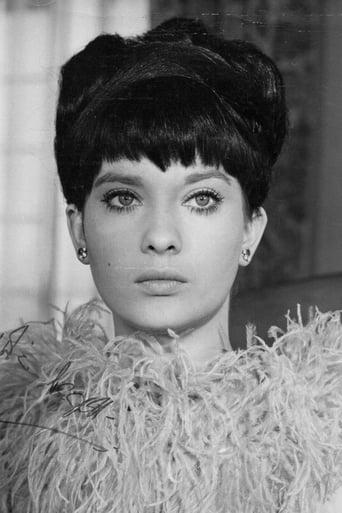ReaderKenka
Let's be realistic.
Baseshment
I like movies that are aware of what they are selling... without [any] greater aspirations than to make people laugh and that's it.
StyleSk8r
At first rather annoying in its heavy emphasis on reenactments, this movie ultimately proves fascinating, simply because the complicated, highly dramatic tale it tells still almost defies belief.
Marva
It is an exhilarating, distressing, funny and profound film, with one of the more memorable film scores in years,
oldblackandwhite
I must add my own two-cents worth to those others who regard Frankenstein: The True Story as the most satisfying film version of of Mary Shelly's 1818 classic. Though it is not a literal translation of the story, it captures the philosophical nature, melancholy mood and epic scope of Mrs. Shelly's novel better than any other celluloid rendition. While keeping the bare bones (no pun intended) of the novel's plot, it dances all around the original story, pulling off plot elements here and there, then sticking them back on elsewhere. For instance, Henri, in the original merely Victor Frankenstein's concerned best friend, is transformed into a mad doctor who gives Victor the monster-making knowledge. In the book Elizabeth was the ward of Victor's father, but Vic is the ward of Liz's dad in True Story. The Dr. Polidori character, played by James Mason oozing evil from every pore, was a brilliant touch, but no such character appears in the novel. Yet, there was a real-life Polidori in Mary Shelly's orbit. He was Shelly friend Lord Byron's personal physician, confidant, and dope supplier. A brilliant young man, who had already published several medical books, he tragically took his own life at age 21 -- according to some, because of his unrequited love for Mary Shelly!True Story owes little to previous movie versions, neither the mossy old 1930's and 'forties Universal Frankenstein series or Hammer's 1950's/'60's revivals, but is a completely fresh approach. The brilliant script by Isherwood and Bachardy is almost as literary as Mrs. Shelly novel, yet even more exciting and stimulating. True Story is a splendid production, probably one of the most handsomely turned out made-for-TV numbers of all time. Period (1797 and following) sets and costumes are exquisite. The cinematography is beautiful, belying its TV origins every step of the way. Unlike most TV movies of the time and practically all current theatrical movies, it disdains the shot-a-second montage method in favor of the mise-en-scene approach -- every scene starts with a precisely composed long shot, which gradually pans in to close-up. This classic style of cinematography complements the beautiful sets, enhances the melancholy mood, and displays the humanity of the characters better than montage. Here it is used brilliantly by director of photography Arthur Ibbetson and director Jack Smight.Frankenstein: The True Story is expertly acted by Mason, Leonard Whiting (Victor), Nicole Padget (Elizabeth), Michael Sarrizan (Creature), Jane Seymour (female creature) and the rest of a fine cast. It is dramatically engaging, thoroughly engrossing for its entire three hours, intellectually stimulating, and gorgeously filmed. A delight from beginning to end. Even Old Hollywood would have been proud to have turned out such a complete motion picture.P.S. -- Those who are interested in learning more about that early 19th century femme fa-tale and the origin of her famous monster story would do well to read Miranda Seymour's superbly researched, highly readable biography of Mary Shelly (Grove Press, NY, 2000).
fertilecelluloid
Full-blooded telling of the Frankenstein story manages to be fresh and original and sustains its running time. There are several terrific performances and possibly the most sympathetic, tragic portrayal of the monster ever by Michael Sarrazin. Dr. Henry Clerval (David McCallum) enlists the services of brilliant surgeon Dr. Victor Frankenstein (Leonard Whiting) to help him create a human being from body parts. As everybody knows, the experiment hits a hiccup and "The Creature" goes bananas. But when Dr. John Pilodori (James Mason) steps up to the plate to construct a second creature with Frankenstein's aid, the drama hits its stride and all hell breaks loose. Some of that "hell" is the understandable anger of Frankenstein's bride (Nicola Pagett), who is forced to spend her wedding night alone while hubby is busy giving life to dead things in his hillside lab. Mason is incredible as the obsessed, insane Polidori, the film's true villain, and does a good job of making us (the audience) loathe the very sight of him. Pagett is strong as the frustrated but devoted wife, and Whiting is a memorable Frankenstein. Also worthy of praise is Ralph Richardson who breathes much life into the role of the Blind Hermit. Sarrazin, however, is a revelation as the decaying, angry, emotionally distraught experiment gone wrong. Because we have seen him proud and happy, it is horrible to watch him physically disintegrate and become persona non grata in the Frankenstein lab. During the creation of Jane Seymour's "Bride", it was devastating to see the dejected Sarrazin witnessing the process, knowing his time had already come and gone. Later, the scene in which he crashes a party and beheads a key character is a classic horror moment and manages to be emotional and grotesque. Aside from the last scene, which has an inexplicable abruptness to it, this is a fantastic Frankenstein adaptation.
Robert J. Maxwell
In the prologue, the script has James Mason, the actor, come out and show us Mary Shelley's grave and explain the origin of the story. Then the script more or less buries Shelley's original under a collapsing iceberg of additional myth, fantasy, and whimsical repetition.This TV miniseries comes in two parts. Part One isn't bad. Leonard Whiting is Victor Frankenstein. David MacCallum is his mentor in building the creature (Michael Sarazzin) using electrical energy and parts of cadavers.Christopher Isherwood was behind the script and -- well, I'll tell you. If this isn't an allegory I don't know what is. Sarazzin, as the creature, climbs from his gurney wearing only a few strips of bandages, his jewels prominent, his face and hair carefully groomed. "Beautiful!" gasps Frankenstein. And with a sweet and beckoning smile the creature repeats, "Beautiful." The two handsome young men get along quite well together, though to be sure one of them is rather dead. Frankenstein's fiancée, Elizabeth, turns pretty much into the beard. Oh, sure, he's engaged to her but we know in which direction his affections lie.But now our story turns a bit. The creature suffers the agonizing fate of every narcissist. He ages -- and quickly. And as he ages his features collapse and seem to rot, so that he shortly begins to look like Dorian Gray's portrait. (Another allegory there, which we needn't go into.) The creature, discovering that he's turned ugly and feeling bitter, begins to brood, and Frankenstein locks him up and begins to pursue his plans with Elizabeth again. The creature gets out and visits Frankenstein and Elizabeth at a fancy ball. He turns out to be one of those rowdy guests you find at every party -- smashing mirrors, windows, and furniture, and killing a few guests.Somewhere around here, Part One ended and Part Two began. Part Two was a mistake. The creature takes a back seat most of the time. Instead, enter Dr. Polidori (James Mason), no relation to the Polidori who shared that weekend with Shelley and the rest. Polidori informs Frankenstein that the BEST way to bring a fabricated body to life is by using chemicals, not electrical energy, and for a moment we expect them to begin arguing like two yentas over the back fence discussing a recipe.At any rate, Polidori enlists Frankenstein's help in creating a female body -- this time using HIS methods. She turns out to be Jane Seymour, which is a considerable improvement over Michael Sarazzin if you ask me, even though we don't get to see her wearing three or four bandages.There's a problem, however. If Frankenstein's monster was flawed in that it aged too quickly, Polidori's creature (whom Polidori names "Prima") turns out to be thoroughly cuckoo. She strangles a cat for no reason. Well, I guess there's ALWAYS a reason to strangle a cat, but some of her other behavior is just plain shocking. I forget most of the other things, but it doesn't matter. Seymour too interrupts a fancy ball, doing a charming, impromptu pas de seul.Now Victor Frankenstein begins to look upon Prima with more than the usual admiration a scientist feels for an invention. Who wouldn't? Elizabeth, now Frankenstein's bride, begins to get jealous -- and so does the original CREATURE, who wrenches off Seymour's head. What a dirty trick.They all wind up dead in the arctic. That includes Frankenstein's creature, although he's described as having an "iron body" impervious to cold and is shown to be immune to bullets too. But I guess he not only doesn't age well. He doesn't travel well either.The acting's not bad and the production values are good for TV. There are many cameos -- Gielgud, Wilding, Moorehead, Richardson, and others -- but the parts aren't substantial.It didn't really matter that the story didn't follow Mary Shelley's original very closely, although many of the issues it raised (science vs. theology) are still relevant. The main problem was that most of Part Two was unnecessary, almost redundant. In Part One Frankenstein invents a flawed male creature. In Part Two Polidori invents a flawed female creature. Almost everything between the end of Part One and the arctic climax could have been snipped out with little loss.Not a badly done movie, though. It's not trashy and it's not insulting. It's just without much significance. Worth seeing once.
dorothia1
i remember watching Frankenstein the true story as a child on TV. There is a scene where Jane Seymour is wearing a black necklace, and someone pulls it off her neck, and her head falls off! I just want to know is this true or not? I know that she was wearing a black necklace, I really need to know if her head falls off when the necklace comes off. I really think this movie was great, and i haven't seen it since i was a child on TV. I really would like to know who else seen this on TV as well. i really don't remember the movie as well as i would like to have, there was only part that stuck in my head till this day,when her head fell off. It was so overwhelming to me. Any feedback will be helpful.




